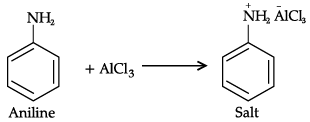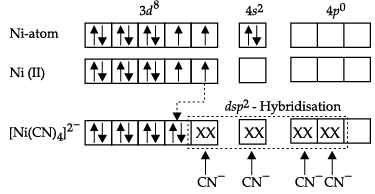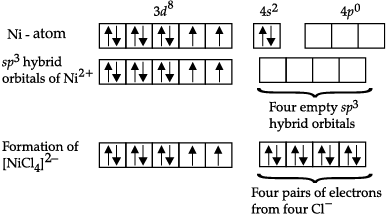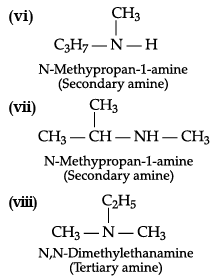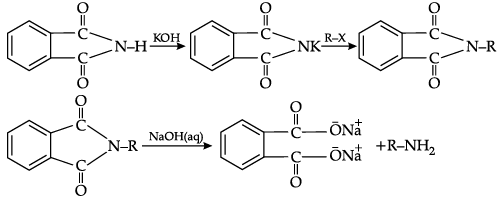Class 12 Chemistry: CBSE Sample Question Paper- Term II (2021-22)- 3 | Sample Papers for Class 12 Medical and Non-Medical PDF Download
| Table of contents |

|
| Class-XII |

|
| Time: 120 Minutes |

|
| Max. Marks: 35 |

|
| Section - A |

|
| Section - B |

|
| Section - C |

|
Class-XII
Time: 120 Minutes
Max. Marks: 35
General Instructions :
- There are 12 questions in this question paper with internal choice.
- SECTION A - Q. No. 1 to 3 are very short answer questions carrying 2 marks each.
- SECTION B - Q. No. 4 to 11 are short answer questions carrying 3 marks each.
- SECTION C- Q. No. 12 is case based question carrying 5 marks.
- All questions are compulsory.
- Use of log tables and calculators is not allowed
Section - A
Q.1. Arrange the following in the increasing order of their property indicated (any two):
(a) Benzoic acid, Phenol, Picric acid, Salicylic acid (pka values).
(b) Acetaldehyde, Acetone, Methyl tert butyl ketone (reactivity towards NH2OH).
(c) ethanol, ethanoic acid, benzoic acid (boiling point)
(a) Picric acid < salicylic acid < benzoic acid <phenol
(b) Methyl tert – butyl ketone < acetone< Acetaldehyde
Detailed Answer:
Out of picric acid, salicylic acid, benzoic acid and phenol, picric acid is the strongest acid due to the presence of three –NO2 group. –NO2 group is an electron withdrawing group and an electron withdrawing group on a benzene ring enhances the acidic character. Out of salicylic acid and benzoic acid, salicylic acid will have more stable conjugate base and hence, more acidic than benzoic acid and stronger will be the acid, lower will be its pka value.
(b)
Acetaldehyde is more reactive than acetone towards nucleophilic addition reaction as acetaldehyde have only one – CH3 group and acetone have two –CH3 group, so +I effect is more in acetone and acetone is also more sterically hindered than acetaldehyde. If we compare methyl-t-butyl ketone and acetone, than, the former one has a very large +I effect
(c) Ethanol < Ethanoic acid < Benzoic acid (boiling point of carboxylic acids is higher than alcohols due to extensive hydrogen bonding , boiling point increases with increase in molar mass) and is very much sterically hindered, so least reactive towards NH4OH.
Q.2. Solutions of two electrolytes ‘A’ and ‘B’ are diluted. The ∧m of ‘B’ increases 1.5 times while that of A increases 25 times. Which of the two is a strong electrolyte? Justify your answer. Graphically show the behaviour of ‘A’ and ‘B’.
B is a strong electrolyte. The molar conductivity increases slowly with dilution as there is no increase in number of ions on dilution as strong electrolytes are completely dissociated.
Q.3. Give reasons to support the answer:
(a) Presence of alpha hydrogen in aldehydes and ketones is essential for aldol condensation.
(b) 3 –Hydroxy pentan-2-one shows positive Tollen’s test.
(a) The alpha hydrogen atoms are acidic in nature due to presence of electron withdrawing carbonyl group. These can be easily removed by a base and the carbanion formed is resonance stabilized.
(b) Tollen’s reagent is a weak oxidizing agent, not capable of breaking the C-C bond in ketones. Thus, ketones cannot be oxidized using Tollen’s reagent itself gets reduced to Ag.
Section - B
Q.4. (a) What are colloids?
(b) Explain lyophobic and lyophilic colloids.
(a) A colloid is an intermediate mixture between a homogeneous mixture known as a solution and the heterogeneous suspension. There are different types of colloids based in the state and interaction between the dispersed phase and dispersion medium. The three main types of colloids are:
- Sol – solid in liquid
- Gel – liquid in liquid
- Emulsion – liquid in liquid
(b) Based on the interaction between the dispersion medium and dispersed phase, sols are classified into two types:
- Lyophilic colloids or lyophilic sols (solvent-loving): In case of water as a dispersion medium, they are known as hydrophilic.
They are easy to prepare just by mixing, shaking or heating substance with the dispersion medium.- Lyophobic colloids or lyophobic sols (solvent-hating): When water is a dispersion medium, they are known as hydrophobic.
They require special methods to prepare and an electrolyte for stabilization.
Q.5. (a) Explain the trend of ionization enthalpy in first row of transition metals.
(b) Why Lanthanoids cannot be separated easily?
(a) Ionization enthalpy is the energy required to remove the most loosely bound electron from the isolated gaseous atoms to produce a cation. Ionization enthalpy of transition elements tend to increase from left to right in the periodic table as there is an increase in nuclear charge which accompanies the filling in the inner d orbitals. However, there are some exceptions, for example, Titanium (Z = 22) has first ionization enthalpy of 656 kJ/mol whereas Vanadium (Z = 23) has first ionization enthalpy of 652 kJ/ mol.
(b) Due to lanthanoid contraction, the change in the atomic or ionic radii of these elements is very small. So, their chemical properties are similar. Hence, lanthanoids cannot be easily separated.
Q.6. (a) A study of reaction A + B → P, gave the following data of chemical kinetics at 298 K.
Calculate the following:
(i) Order of the reaction
(ii) Rate constant of the reaction
(b) Explain why H2 and O2 do not react at room temperature.
(a) From the experimental data,
Rate law expression,
R = k[A]m[B]n
4.20 × 10–6 = k[1.0]m[0.15]n ...(i)
8.40 × 10–6 = k[2.0]m[0.15]n ...(ii)
5.60 × 10–6 = k[1.0]m[0.20]n ...(iii)
Dividing (ii) by (i), we get
⇒ 2 = 2m
⇒ m = 1
Similarly, dividing (iii) by (i), we get
⇒ 4/3 = (4/3)n
⇒ n = 1
(i) Order of the reaction, m + n = 1 + 1 = 2
(ii) From equation (i) we get, 4.20 × 10–6 = k(1)1(0.15)1
⇒ (4.2 x 10-6)/0.15 = k
k = 8.07 × 10–6 units
(b) Due to high activation energy of the reaction between O2 and H2.
Q.7. (a) Explain the intermolecular association in primary, secondary and tertiary amines.
(b) Write an isomer of C3H9N which gives foul smell of isocyanide when treated with chloroform and ethanolic NaOH.
OR
Give reasons:
(a) Aniline does not undergo Friedel-Crafts reaction.
(b) (CH3)2 NH is more basic than (CH3)3 N in an aqueous solution.
(c) Primary amines have higher boiling point than tertiary amines.
(a) Primary and secondary amines are often engaged in the intermolecular association as a result of hydrogen bonding between the nitrogen of one and hydrogen of the other molecule.
The intermolecular association is more prominent in case of primary amines as compared to secondary due to the availability of two hydrogen atoms.
In tertiary amines, there is no intermolecular association due to the absence of free hydrogen atom for bonding.
(b) Isomer ofgives foul smell of isocyanides (because primary amine gives carbylamine reaction.)

OR
(a) Aniline is a Lewis base while AlCl3 is lewis acid. They combine to form a salt.
(b) Due to combined +I and solvation effects.
(c) Due to presence of H-bonding in primary amines.
Detailed Answer:
(a) Friedel Crafts reaction is carried out in the presence of AlCl3. But AlCl3 is used as a catalyst and is acidic in nature whereas aniline is a strong base. Thus, aniline reacts with AlCl3 to form a salt.Due to the positive charge on the N— atom, electrophilic substitution in the benzene ring is deactivated. Hence, aniline does not undergo Friedel—Crafts reaction.
(b) (CH3)2 NH is more basic than (CH3)3N in an aqueous solution. +I effect will increase due to alkyl group that results in increasing the donation of lone pair of electron. Amine accepts a proton and from cation which will be stabilised in water by solvation. But greater the size of ion, lower will be the solvation in aqueous solution. Higher the solvation by hydrogen bonding, higher will be the basic strength.
Therefore, with increase in methyl group, hydrogen bonding and stabilisation by solvation decreases. This net effect results in decreases of basic strength from secondary to tertiary amine.
(c) In tertiary amines, there are no H-atoms whereas, in primary amines, two H-atoms are present. Due to the presence of H-atoms, primary amines undergo extensive intermolecular H-bonding.
As a result, extra energy is required to separate the molecules of primary amine. Therefore, primary amines have higher boiling point than tertiary amines.
Q.8. The magnetic moment of few transition metal ions are given below:
(Atomic no. Sc = 21, Ti = 22, Cr = 24, Ni = 28)
Which of the given metal ions:
(a) has the maximum number of unpaired electrons?
(b) gives colourless aqueous solution?
(c) exhibits the most stable +3 oxidation state?
OR
Observed and calculated values for the standard electrode potentials of elements from Ti to Zn in the first reactivity series are depicted in figure (1):
 Explain the following observations:
Explain the following observations:
(a) The general trend towards less negative E° values across the series.
(b) The unique behaviour of Copper.
(c) More negative E° values of Mn and Zn.
(a) Magnetic moment, μ =
Where, n = No. of unpaired electrons Higher the magnetic moment, higher will be the number of unpaired electrons.
μCr+3 = 4.9 BM
Hence, Cr+3 has maximum number of unpaired electrons.
(b) Colour in aqueous solution is due to partially filled (n –1)d-orbitals i.e., presence of unparied electrons. So, except Sc+3 (μ = 0.00 BM) rest are coloured in aqueous solution. Because, μ = 0 BM shows, unavailability of unpaired electrons.
(c) Sc3+has stable +3 oxidation state because electronic configuration of Sc+3(3d°45°) aquires stable noble gas configuration. Rest all have incomplete octet such as:
Cr+2 : [Ar] 3d44s0
Ni+2 : [Ar] 3d84s0
Ti+3 : [Ar] 3d14s0
OR
(a) The general trend towards less negative E° values across the series is related to the general increase in the sum of the first and second ionization enthalpies.
(b) Copper is the only d-block element which has positive reduction potential, thus require high enthalpy to convert Cu to Cu+2. The high energy to transform Cu(s) to Cu2+ (aq) is not balanced by its hydration enthalpy.
(c) The stability of the half-filled d sub-shell in Mn2+ and the completely filled d10 configuration in Zn2+ are related to their more negative E° values.
Q.9. Explain on the basis of Valence bond theory that [Ni(CN)4]2– ion with square planar structure is diamagnetic and [NiCl4]2– ion with tetrahedral geometry is paramagnetic.
OR
(a) What type of isomerism is shown by the complex [Co(NH3)5 (SCN)]2+?
(b) Why is [NiCl4]2– paramagnetic while [Ni(CN)4]2– is diamagnetic ? (Atomic number of Ni = 28)
(c) Why are low spin tetrahedral complexes rarely observed ?
Ni+2 has d8 configuration. In presence of 4 CN– ions, it can either have square planar or tetrahedral geometry. Since, CN– is strong ligand, it causes pairing of unpaired 3d electron.
Hence, Ni in [Ni(CN4)]2– undergoes dsp2 hybridization. Since, all electrons are paired, it is diamagnetic.While in case of [Ni(Cl4)]–2, Cl– is weak ligand. In presence of weak ligand, it doesn't lead to pairing of unpaired 3d electrons. Since, there are 2 unpaired electrons left in 3d which are not paired, [Ni(Cl4)]–2 is paramagnetic. Hence, it undergoes sp3 hybridization.
OR
(a) Linkage isomerism.
(b) In [NiCl4]2–, due to the presence of Cl– (a weak field ligand) no pairing occurs whereas, in [Ni(CN)4]2–, CN– is a strong field ligand and pairing takes place.
(c) Because of very low CFSE which is not able to pair up the electrons.
Q.10. Compound 'A' was prepared by oxidation of compound 'B' with alkaline KMnO4. Compound 'A' on reduction with lithium aluminium hydride gets converted back to compound 'B'. When compound 'A' is heated with compound 'B' in the presence of H2SO4 it produces fruity smell of compound 'C' to which family the compounds 'A', 'B' and 'C' belong to?
'A' is carboxylic acid (R – COOH), 'B' is an alcohol (R – CH2OH) and 'C' is an ester (RCH2 – COOR).
Q.11. (a) Write the structures of different isomeric amines corresponding to the molecular formula, C4H11N and their IUPAC names.
(b) What type of isomerism is exhibited by different types of amines in the above question?
OR
(a) Write the reactions involved in the following:
(i) Hoffmann bromamide degradation reaction
(ii) Gabriel phthalimide synthesis
(b) Give reason:
(CH3)2NH is more basic than (CH3)3N in an aqueous solution.
(a) The isomers of C4H11N are:
(b) Isomerism exhibited by different amines:
- Chain isomers: (i) and (ii); (iii) and (iv); (i) and (iv)
- Position isomers: (ii) and (iii); (ii) and (iv)
- Metamers: (v) and (vi); (vii) and (viii)
- Functional isomers: All the three types of amines are the functional isomers of each other.
OR
(a) (i) Ar/ R-CONH2 + Br2 + 4NaOH → Ar/ R-NH2 + 2NaBr + Na2CO3 + 2 H2O
(ii)
(b) Because of the combined factors of inductive effect and solvation or hydration effect.
Detailed Answer:(b)
2° amine salt form is more stable than 3° amine due to inductive effect and higher degree of hydration. Therefore, higher the stability of salt, greater will be the reactivity of corresponding compound.
Section - C
Q.12. Read the passage given below and answer the following questions:
The rate of the reaction is proportional to the concentration of the reactant. Hydrogenation of ethene results in the formation of ethane. The rate constant, k for the reaction was found to be 2.5 × 10–15s–1. The concentration of the reactant reduces to one-third of the initial concentration in 5 minutes.
(a) What is the order of the reaction ?
(b) Depict the rate law equation for the hydrogenation of ethene.
(c) Find the half-life of the reaction.
(d) What will be the rate constant of the reaction after 5 minutes?
OR
(d) Find the slope of the curve in the reaction.
(a) Since, the rate of the reaction is proportional to the concentration of the reactant i.e., ethene so, it is first order reaction.
(b)
Here, hydrogen is taken in excess so the reaction is first order reaction.
Rate law equation, Rate = k [C2H4]
(c) For first order reaction,
t1/2= 0.693/k
(d) Given, t = 5 min
For first order reaction,
= 0.2197 min-1
OR
Since, k = 1/t ln [Ro]/[R]
kt = ln[Ro]– ln [R]
ln [R] = –kt + ln [Ro]
y = mx + c
So, m = –k
Slope = –k
|
159 docs|4 tests
|







